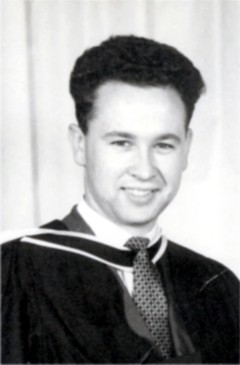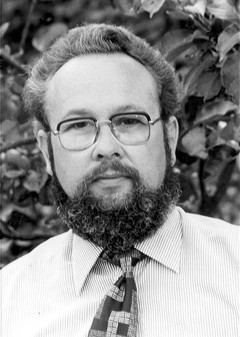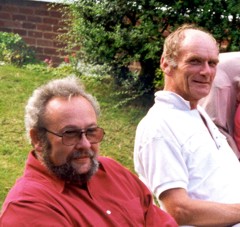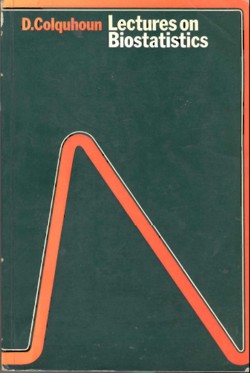Here are reprints of single channel theory papers, and older experimental papers with theoretical content. Almost all of them could not have been written without the amazing stochastic insight of Alan G Hawkes (1938 – 2023). The death of Alan Hawkes, in November 2023, has left a hole in my life.
 Alan Hawkes, 1960 |
 Alan Hawkes 1989 |
 Alan Hawkes & DC, 1997 |
 Alan Hawkes with Fig from 1977 paper |
The papers in Royal Society Journals are available (right back to 1665) on the JSTOR site.
Colquhoun, D.(1970). How long does a molecule stay on the receptor? Explanation of a paradox. British Journal of Pharmacology 39, 215P [Get PDF]
This is the abstract of a talk given at the 1969 meeting of the British Pharmacological Society. At the time I had just discovered, via Alan Hawkes, the waiting time paradox. This resolved, at a stroke, many of the problems that I’d been having in thinking about what happened at the level of a single drug-receptor complex.
Colquhoun, D. & Hawkes, A. G. (1977). Relaxation and fluctuations of membrane currents that flow through drug-operated channels. Proceedings of the Royal Society London B 199, 231-262.
[Get pdf]]
This 1977 paper is the first of many papers written with Alan Hawkes. Its origin dates back to 1972 when I wrote Alan Hawkes to ask how the noise analysis, recently published by Katz & Miledi, could be generalised to any reaction mechanism. The theory predicted that the predominant time constant from noise analysis would be longer than the mean channel open time, for any realistic values of the rate constants. The physical meaning of this eluded us at first, but after being pressed by Bernard Katz to explain the result, we realised that it was a result of channel openings being predicted to not to occur singly, but in bursts. By the time the paper came out, Neher & Sakmann’s 1976 paper had appeared and we were soon able to test the prediction,
[#ch77]
Colquhoun, D. & Sakmann, B. (1981) Fluctuations in the microsecond time range of the current through single acetylcholine receptor ion channels. Nature 294, 464-466. [Get pdf]
The first experimental paper to test the predictions made in Colqhoun & Hawkes (1977) and the first attempt to measure separately binding (affinity) and gating (efficacy). Superseded by the much more complete account in Journal of Physiology (1985). [#ch81]
Colquhoun, D. & Hawkes, A.G. (1982) On the stochastic properties of bursts of single ion channel openings and of clusters of bursts. Philosophical Transactions of the Royal Society London B 300, 1-59. [Get PDF]
This is the paper that describes the notation used in all subsequent papers, and uses it to obtain distributions of open and shut times, of burst properties, and the properties of clusters of bursts (it supersedes the 1981 paper, and it has far more citations, despite the 1981 paper being in Nature) [#ch82]
Colquhoun, D. & Sakmann, B. (1985). Fast events in single-channel currents activated by acetylcholine and its analogues at the frog muscle end-plate. Journal of Physiology ( London ) 369 , 501-557. [Get pdf]
Largely experimental paper, the first to apply the theory systematically to experimental results. In 1985 we did not have the full missed events solution so maximum likelihood fitting was not possible. A crude post hoc approach to missed events was taken, and it turnedout to be quite a good approximation, See also the Classical Perspective on this paper, written in 2007. [#cs85]
Ogden, D. C. & Colquhoun, D. (1985). Ion channel block by acetylcholine, carbachol and suberyldicholine at the frog neuromuscular junction. Proceedings of the Royal Society London B 225, 329-355.
[Get pdf]
This paper has two appendices of general interest. Appendix 1 gives algebraic reults for the area under a Lorentzian spectral density function that has been filtered with an 8-pole Butterworth filter. Appendix 2 uses the theory of clusters of bursts (C& H 1982) to analyse the effects of ion channel blockers that are not selective for the open state. [#oc1985]
Colquhoun, D. & Hawkes, A. G. (1987). A note on correlations in single ion channel records. Proceedings of the Royal Society London B 230, 15-52 [Get pdf]
This 38 page “note” describes the theory of correlations.between open and shut times. These are predicted by most mechanisms and provide a useful test of goodness of fit. Our programs are they only ones that allow this sort of test, though they didn’t become usable until they were extended to take account of missed events. [#ch87]
Colquhoun, D. and Ogden, D.C. (1988). Activation of ion channels in the frog end-plate by high concentrations of acetylcholine. Journal of Physiology, 395, 131-159.
[Get pdf] [#co1998]
Hawkes, A. G., Jalali, A. & Colquhoun, D. (1990). The distributions of the apparent open times and shut times in a single channel record when brief events can not be detected. Philosophical Transactions of the Royal Society London A 332, 511–538.[Get PDF]
This paper describes the exact solution of the missed event problem, which is the basis for the HJCFIT program. The solution is piecewise and becomes computationally difficult for long time intervals, The discovery of a (very good) asymptotic approximation in 1992 makes computation feasible. [#hjc90]
Jalali, A. & Hawkes, A. G. (1992). Generalised eigenproblems arising in aggregated Markov process allowing for time interval omission. Advances in Applied Probability 24, 302–321. [Get PDF]
This paper has nothing to do with UCL, but it’s included here because lays the mathematical basis for the solution to the missed event problem. It is basis on which we were able to write a program, HJCFIT which allows maximum likelihood fitting of single ion channel results with exact allowance for missed brief events. See next paper for more details.
It’s a good example of the folly of counting citations, because it’s had far fewer citations than the work that uses the far-from-simple mathematics that are presented in this paper. [#jh92]
Hawkes, A. G., Jalali, A. & Colquhoun, D. (1992). Asymptotic distributions of apparent open times and shut times in a single channel record allowing for the omission of brief events. Philosophical Transactions of the Royal Society London B 337, 383–404. [Get PDF]
This paper describes a very good approximation to the exact solution of the missed event problem, which is used in the HJCFIT program, for events longer than 3 deadtimes. The asymptotic solution is a mixture of (the right number of) exponentials, with appropriate time constants and areas to describe the apparent distributions. The distribution of apparent open and shut times (HJC distributions) is not described by the classical mixture of exponentials for very short events, for which the exact solution is used. [#hjc92]
Colquhoun, D. & Hawkes, A. G. (1990). Stochastic properties of ion channel openings and bursts in a membrane patch that contains two channels: evidence concerning the number of channels present when a record containing only single openings is observed. Proceedings of the Royal Society London B 240, 453-477. [Get pdf]
This paper makes a contribution to the difficult problem of how to tell whether a patch contains more than one channel. It calculates exactly the duration of runs of single openings in a membrane patch that contains two active channels. An approximation is also provided. If the observed run of single openings is much longer than that expected for a patch with two channels it is likely that only one channel was active. [#ch90]
Béhé, P., Stern, P., Wyllie, D. J. A., Nassar, M., Schoepfer, R. & Colquhoun, D. (1995). Determination of the NMDA NR1 subunit copy number in recombinant NMDA receptors. Proceedings of the Royal Society London B 262, 205-213. [Get pdf]
This paper used co-expression of wild type and mutated receptors to determine that there seemed to be two copies of the NR1 subunit in an NMDA receptor.
[#bsc92]
Colquhoun, D. & Hawkes, A. G. (1995). Desensitization of N-methyl-D-aspartate receptors: a problem of interpretation. Proceedings of the National Academy of Sciences, USA 92, 10327-10329. [Get pdf]
A paper by Lin, F. & Stevens, C. F. (1994) (J. Neurosci, 14, 2153-2160). attempted to cast light on the mechanism of desensitization of N-methyl-D-aspartate (NMDA) receptors. The conclusion of that paper that “desensitization occurs more rapidly from the open state”. We show that this conclusion was based on a stochastic fallacy, and we present a theoretical treatment and illustration showing that the observed behavior is predicted by a simple mechanism in which desensitization can occur only from a shut state. [#ch95]
Colquhoun, D., Hawkes, A. G. & Srodzinski, K. (1996). Joint distributions of apparent open times and shut times of single ion channels and the maximum likelihood fitting of mechanisms.Philosophical Transactions of the Royal Society London A 354, 2555–2590. [Get PDF]
The paper extends the treatment of correlations between open and shut times by deriving the expressions for joint and conditional distributions with exact allowance for missed brief events. This opened the door to maximum likelihood fitting which is described in this paper and which has been implemented in the HJCFIT program. [#chs96]
Wyllie, D. J. A., Béhé, P., Nassar, M., Schoepfer, R. & Colquhoun, D. (1996). Single-channel currents from recombinant NMDA NR1a/NR2D receptors expressed in Xenopus oocytes. Proceedings of the Royal Society London B 263, 1079-1086. [#wnsc96]
Wyllie, D. J. A., Béhé, P. & Colquhoun, D. (1998). Single–channel activations and concentration jumps: comparison of recombinant NR1a/NR2A and NR1a/NR2D NMDA receptors. Journal of Physiology (London) , 510,1–18.  [Get PDF]
This paper gives the general theoretical relationship, for any Markov mechanism, between the shape of macroscopic currents and the properties of the underlying bursts of single channel openings, and tests the predicted relationship experimentally on NMDA receptors. [#wbc98]
Colquhoun, D., Hawkes, A. G., Merlushkin, A. & Edmonds, B. (1997). Properties of single ion channel currents elicited by a pulse of agonist concentration or voltage. Philosophical Transactions of the Royal Society London (Physical Sciences) A 355, 1743-1786. [Get pdf]
This paper deals with single channels that are not in a steady state (for example, behaviour after a jump in concentration or voltage), with exact correction for missed events. The usefulness of things like the distribution of the time to the first opening after a jump is limited by the need to have a patch that contains only one channel. [#chme97]
David Colquhoun, Kathryn Dowsland, Marco Beato and Andrew Plested. (2004). How to impose microscopic reversibility in complex reaction mechanisms. (with appendix by Kathryn. A. Dowsland and Frank G. Ball)
Biophysical Journal, 86, 3510–3518. [Get PDF]
This paper describes three different methods for ensuring that microscopic reversibility is obeyed. It uses a graph theory approach. The relation of the problem to spanning trees is fascinating. Note that the method given in appendix 2 of this paper is the same as that used in the current version of the MIL program in the QUB suite (Qin, personal communication, and Qin et al 1996)) [#cdbp04]
Colquhoun, D., Hatton, C., & Hawkes, A. G. ( 2003) The quality of maximum likelihood estimation of ion channel rate constants . Journal of Physiology (London) 547, 699–728. [Get pdf]
A study of the ability of the HJCFIT method to extract rate constants for a reaction mechanism from a sequence of open and shut times. Our analysis was applied to a large number of ‘experiments’ that were generated by simulation, so the true values for the rate constants were known. Sampling distributions are shown for the fitted parameters. HJCFIT is the only fitting method that has been tested in this way. [#chh03]
Colquhoun, D. ( 2005) Stephenson, affinity and efficacy in 2005 pA2 magazine, 3 (4), (2005) [Get PDF]
This was a commentary on the mistakes in the formulation of the ideas of affinity and efficacy in the classical work of R,P, Stephenson. The British Pharmacological Society has allowed the issue of pA2 in which it appeared to vanish from the web. It was written a year after Stephenson’s death, partially in reaction to the error being perpetuated in obituaries. It doesn’t contain much that I hadn’t said already, in greater detail, in the 1998 review, apart from the fact that I now felt free to discuss conversations that I’d had about these topics with Stephenson since 1964 (when I first met him). [#dc05]
Papers and videos about statistical inference and p values can now be found on a separate page: Some papers about p values
Obituaries for Bernard Katz (1911 – 2003)
| Professor Sir Bernard Katz. Biophysicist who arrived in England with £4 and went on to win a Nobel Prize (Obituary) Independent 26 April 2003 [Get PDF] or reproduction of Newspaper version |
Professor Sir Bernard Katz. A longer account of his life from Physiology News (Autumn 2003, number 52, pp 34–38) [Get PDF]
Inside front cover (portrait) [Get PDF]
Inside back cover (scenes from BK’s life) [Get PDF] [#bk03]
Colquhoun, D. (1987). Affinity, efficacy and receptor classification: is the classical theory still useful? In Perspectives on hormone receptor classification, ed. Black, J. W., pp. 103-114. Alan R. Liss Inc., New York.
[get pdf file: 2.35 Mb]
This paper explains why Stephenson’s quantitative formulation contained an error, and how this error implied that none of the published methods for experimental determination of ‘affinity’ and ‘efficacy’ could actually achieve the separation of these quantities that had been claimed for them. [#dc1987]
Colquhoun, D. (1963) Balanced incomplete block designs in biological assay illustrated by the assay of gastrin using a Youden square. British Journal of Pharmacology and Chemotherapy 21, 67-77.
[get pdf file:]
My first ever paper in a real journal. It was a hobby topic, a side project done during the second year of my PhD in Edinburgh,to help a colleagues who was trying to assay gastrin. I found the statistics fascinating, and still do. [#dc1963]
Lectures on Biostatistics (1971)
More details, and a review, can be found on dcscience.net.
The whole book can now be downloaded, free for now. Download the corrected searchable pdf file.
Some classical papers
Hill, A.V. (1909) The mode of action of nicotine and curari determined by the form of the contraction curve and the method of temperature coefficients. J. Physiol. (Lond),39, 361-373. [Get pdf (0.58 Mb)]
This is A.V. Hill’s first paper. It describes the Langmuir equation (both rates and equilibrium) some time before Langmuir (1918) did so.
[#avh1909]
Haldane, J.B.S. (1930) Enzymes, Longmans, Green and Co.London. [Get pdf (0.31.Mb)]
This is the section of Haldane’s book that describes mechanisms: Michaelis-Menten and Briggs-Haldane, and in particular the case of competitive inhibition (see pp 46-47 of book, pp 20-21 of pdf file). [#jbsh1930]
del Castillo J & Katz B (1957). Interaction at end-plate receptors between different choline derivatives. Proc R Soc Lond B 146:369-381 [Get pdf (1.49 Mb)]
This is the paper that first distinguished explicitly between binding and gating (or affinity and efficacy). [#dck1957]

 [#lob]
[#lob]
Pingback: UCL’s senior common room and the Boston marathon: emancipation in the 1960s, and now